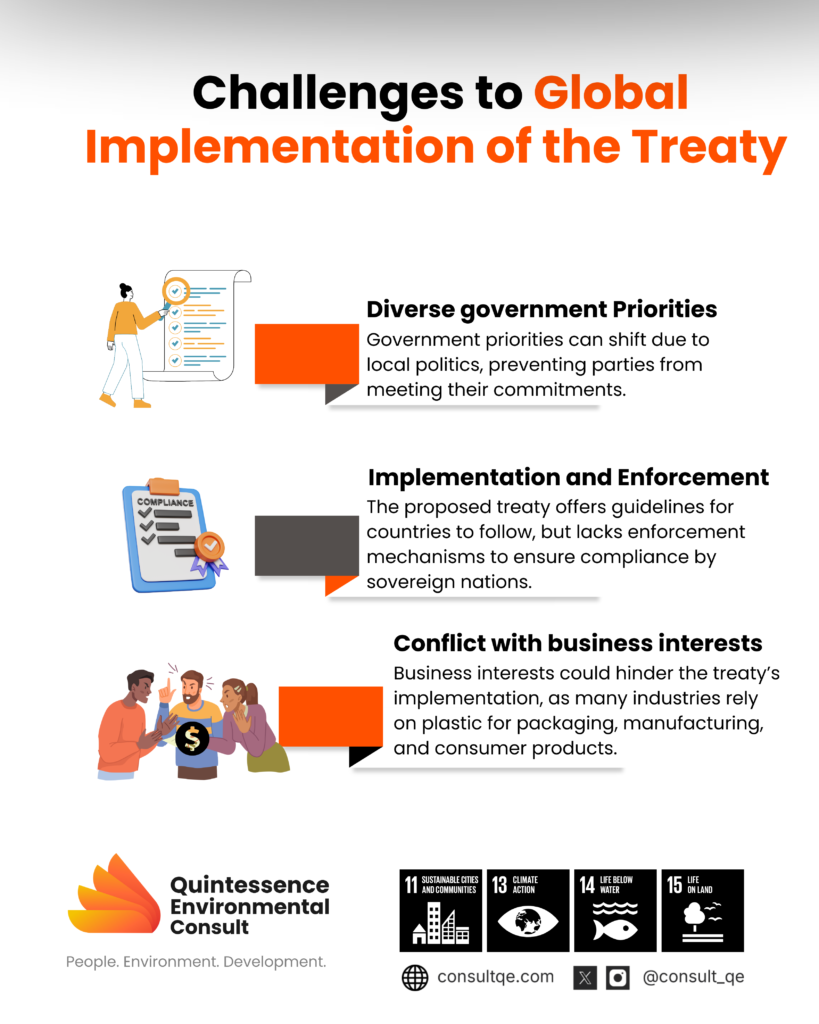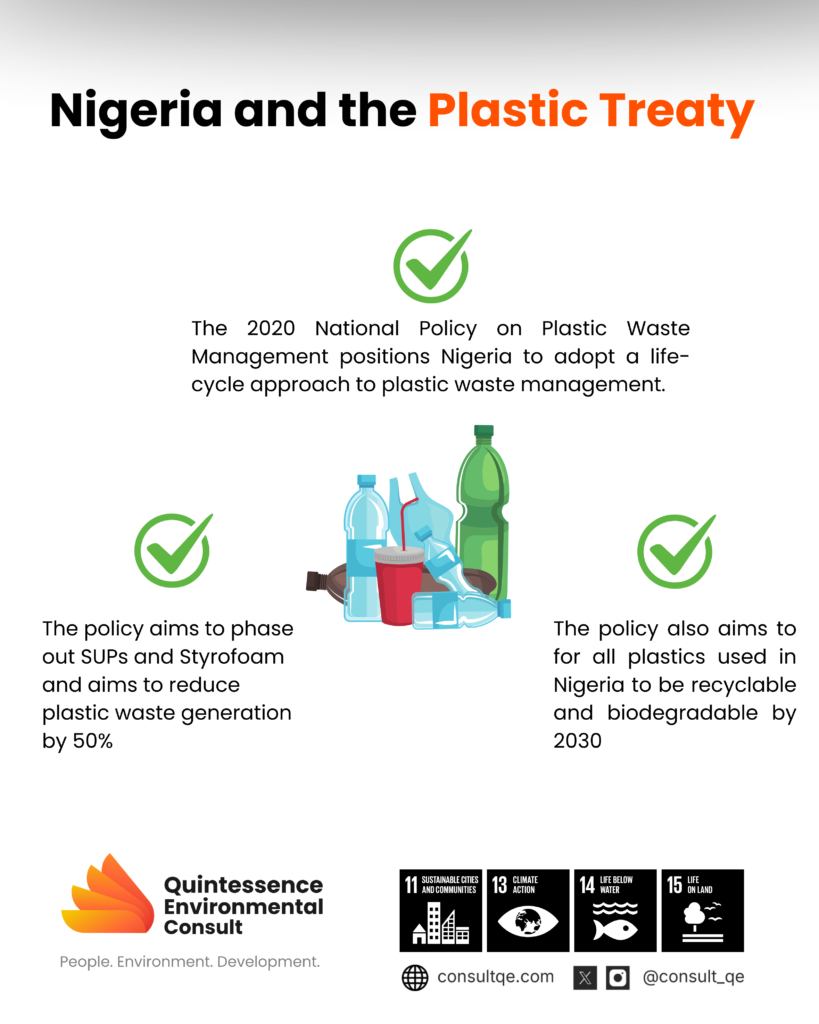
KEY TAKEAWAYS
- The Intergovernmental Negotiating Committee (INC) of the UNEP is developing a binding international framework for managing plastic waste.
- Significant progress has been made at the 5th meeting of the INC with proposals of a plastics production cap, clearing existing plastics, technology transfer and financing the provision of the proposal.
- Several challenges may hamper the success of the treaty when eventually ratified including conflict with business interests, political and policy priorities of member countries, and lack of power of enforcement over parties
- The national policy on plastic waste management proposed by Nigeria has provisions that are very much in line with those of the INC, showing that Nigeria is moving in the right direction.
- Sub-national governments in Nigeria may not see plastic waste as a priority issue and may require incentives to take action.
INTRODUCTION
Plastic waste accumulating in oceans, waterways, and landscapes has become a global challenge, causing harm to wildlife, ecosystems, and human health. The Plastic Treaty refers to a proposed Intergovernmental Legally Binding Instrument (ILBI) that seeks to tackle plastic pollution throughout its entire lifecycle, from production and consumption to waste management and disposal. The need for this treaty was raised in resolution 5/14 at the United Nations Environment Assembly (UNEA) of the United Nations Environmental Program (UNEP) on March 2, 2022[1]. As of December 2022, 175 countries have joined the negotiation process on the Treaty.
The treaty is to be drafted by the Intergovernmental Negotiating Committee(INC), convened by the United Nations Environmental Program (UNEP), taking into account the principles of the Rio Declaration but with differentiated responsibility to individual nations’ circumstances and capabilities. The fifth and supposed final session of the INC (INC-5.1) took place in Busan, South Korea, in November 2024, but it ended without an agreement. A second part of the 5th session (INC-5.2) is scheduled for August 2025 in Geneva, Switzerland[2].
The treaty, when finally agreed upon and judiciously implemented by member countries, is expected to reduce Plastic Production, Consumption and disposal, promote sustainable Waste Management practices, Recycling, and support Research and Innovation. The proposed plastic treaty includes 32 articles, some of which offer a framework for ratification, documentation, and implementation, while others address core issues of plastic waste, such as plastic production caps, existing plastic waste, and improvement of plastic design and its alternative materials.
The implementation seeks to preserve the economic development of the parties, not disrupt international trade, protect local customs, and cultural heritage. The implementation of the treaty will be monitored and regulated by a conference of parties
Some of these core issues are elaborated further on below.
Plastic production Caps and alternatives: According to Article 3 of the proposed treaty, member countries are to end the production and consumption of certain categories of plastics listed in Annex X and Y after a yet to be agreed upon date but after 2030. These products include single-use plastics and plastics containing certain toxic compounds, including DEHP (CAS number 117-81-7), DBP (CAS number 84-74-2), BBP (CAS number 85-68-7) and IBP (CAS number 84-69-5), as well as children’s toys containing heavy metals, such as lead and chromium. Article 4 allows member countries, according to their respective socioeconomic goals, to seek to delay enforcement of the ban not later than 5 years after the stipulated dates. Articles 5 and 6 proposed research into better design and sustainable alternatives to plastic to ensure circular economy practices[3].
Waste management: Articles 7 to 9 focus on waste management, including guidance against the leakage of plastic waste into unregulated systems as well as dealing with existing plastic waste. It emphasized the primacy of the Basel Convention on the Control of Transboundary Movements of Hazardous Wastes. Member countries are encouraged to set targets to increase the collection and recycling rates of plastic waste, identify plastic accumulation zones and engage in joint clean-up campaigns, especially for transboundary waste.[3]
Technology transfer and Financing mechanism: The treaty’s success depends on robust technology transfer and adequate financing. As the developed countries have generally contributed disproportionately to the plastic problem, they equally bear a disproportionate burden of the financial commitment. Developed parties are expected to fund the treaty through primary plastic polymer fees, extended producer responsibility schemes, development strategies, bilateral & multilateral funding, private sector investment, voluntary contributions, and national budgets. The fund (Global Environment Facility Trust Fund) will be managed by the conference of parties. Priority of access is given to the most vulnerable countries, such as least developed countries (LDCs), landlocked nations, small island developing states (SIDS), lower riparian countries and archipelagic states[3].

POTENTIAL THREAT TO THE GLOBAL IMPLEMENTATION OF THE TREATY
Conflict with business interests: Business interests may clash with the implementation of the treaty, as many industries depend on plastic products for packaging, manufacturing, and consumer goods. The economic interests of these industries could directly conflict with the treaty’s regulations, especially Article 3, which calls for a ban on the production and consumption of specific types of plastics.
Diverse government Priorities: Government priorities can shift due to local politics, preventing parties from meeting their commitments. A clear example of this is the current U.S. president, Donald Trump. Since taking office, he has withdrawn from several multilateral agreements[4], including the climate change agreement, and has expressed his opposition to the plastic treaty. He also reversed the ban on plastic straws in place before his presidency [5]. Such actions from the president pose a significant threat to the success of the treaty. Moreover, countries experience varying levels of plastic pollution, making it difficult to create a global treaty that is fair and equitable for both developed and developing nations. This fear exists despite the financial obligations the treaty imposes on developed countries. This disparity partly contributed to the inability of members to reach an agreement during the recent INC meeting in Busan, South Korea.
Implementation and Enforcement: The proposed treaty provides guidelines to help countries adhere to its provisions, but there are no mechanisms in place to force sovereign nations to comply if they fail to do so. Additionally, several clauses in the treaty are ambiguous and open to different interpretations. For instance, the treaty allows for provisions to be suspended if they conflict with a member nation’s socioeconomic development plans. But who decides when this applies? It is also challenging to monitor how funds given to developing countries are being used for their intended purposes.
NIGERIA’s CURRENT REALITY AND PROSPECTS ON PLASTIC TREATY
It’s encouraging to see that Nigeria, at the national and subnational levels, are taking bold steps to address the problem of plastic waste. For instance, Lagos State has implemented a ban on Styrofoam and single-use plastics (SUPs), which took effect in January 2025.
At the Federal level, the 2020 National Policy on Plastic Waste Management proposes a life-cycle approach to plastic waste management. The policy aims to phase out SUPs and Styrofoam between 2025 and 2028, reduce plastic waste generation by 50%, and ensure that all plastics used in Nigeria are recyclable and biodegradable by 2030[7]. These objectives align closely with the proposals in the global plastic treaty. Therefore, Nigeria is moving in the right direction with its plastic waste management policies.
Potential Challenges to Local Implementation of the Treaty:
In a federal system like Nigeria’s, ensuring compliance at the subnational level, where the real challenges lie, can be difficult. State governments may not see plastic waste with the same urgency as the federal government. When they do, competing socio-economic priorities, poor road infrastructure, lack or inadequate funds may militate against its implementation. Furthermore, the volume of waste generated at subnational levels is usually too small to support business case for large scale investments in waste management technologies such as biofertilizer plants, waste to energy using incinerators etc.

Recommendations
To address some of these challenges, the federal government could incentivize plastic waste management by offering financial rewards to local governments that meet specific, measurable, and verifiable targets set in the national policy.
The federal government may also facilitate access to grants for states that domesticate the national plastic waste policy and have shown clear action plans for its implementation. States with low volume of waste generation, may collaborate with neighboring state to facilitate adequate supply of waste to feed technologies such as biofertilizer plants, electricity generating incinerators etc
CONCLUSION
The Plastic Treaty is a crucial step in combating the global plastic pollution crisis. While challenges remain in negotiating and implementing a comprehensive solution, the treaty represents a landmark commitment from governments worldwide to address one of the most pressing environmental issues of our time. With coordinated global action, a legally binding treaty can provide the framework needed to significantly reduce plastic waste, protect ecosystems, and promote a more sustainable future.
REFERENCES
1.5/14. End Plastic Pollution: Towards an International Legally Binding Instrument – Resolution adopted by the United Nations Environment Assembly on 2 March 2022 [UNEP/EA.5/Res.14](Information on reports and updates by the Technology and Economic Assessment Panel)
2.https://www.unep.org/inc-plastic-pollution/session(First Part of the Fifth Session | UNEP – UN Environment Programme)
3.https://wedocs.unep.org/bitstream/handle/20.500.11822/47162/INC_5_1_Report.pdf(INC_5_1_Report.pdf)
4.By James Darley, 2025: What Donald Trump’s Presidency Means for Plastic Pollution. Sustainability magazine(What Donald Trump’s Presidency Means for Plastic Pollution| Sustainability Magazine)
5.Associated press, 2025: Back to plastic’: Trump signs order for plastic straws as he declares paper ones ‘don’t work.(Trump signs order for plastic straws as he declares paper ones ‘don’t work’ | AP News)
6. Punch 2024: Lagos to ban single-use plastics, sachet water from January 2025(Lagos to ban single-use plastics, sachet water from January 2025)
7. Federal Ministry of Environment, 2022: National Policy on Plastic Waste Management(National Policy on Plastic Waste Management – Federal Ministry of Environment)
